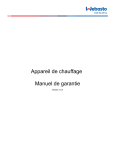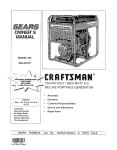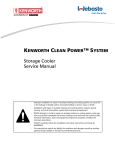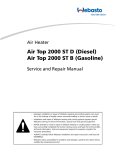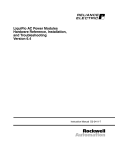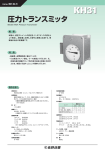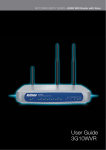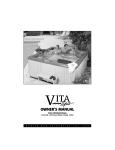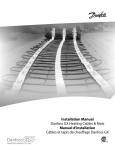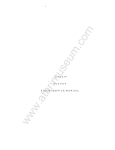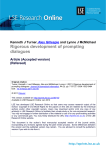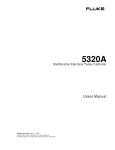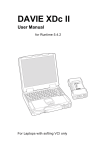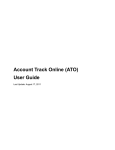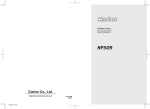Download Kenworth Clean Power System - Webasto Technical Support Website
Transcript
Kenworth Professional Service Workbook No. 2, 2007 • Volume 80 Featuring: Kenworth Clean Power™ System Fuel-Fired Heater (in passenger’s side tool box) Enhanced Insulation LED Lighting Air Conditioning Charge Unit High Output Alternator Starter Batteries Disconnect Switch (cab floor) Main Battery Disconnect Switch Shore Power Connector (120 VAC) Main Battery Box Starter Batteries Main Batteries Circuit Breaker Box (in driver’s side tool box) k kboo you r o W ive This d to g mponents e n g i o is des rview of c chniques. e v fo ing te . a brie ubleshoot etails d o r r t o f and e8 ag See p Storage Cooler (under lower bunk) Components Kenworth Clean Power™ System Components Kenworth’s Clean Power™ System is designed to keep a vehicle’s sleeper cool in summer and warm in winter for up to 10 hours with no need to idle the engine. It’s a battery-powered climate control system, independent from the cab’s air conditioner and heater, with its own separate heating and cooling sources. In addition, there’s enough battery power so the driver can operate any 120-Volt AC accessories. Clean Power features and benefits: CONTENTS • Clean Power keeps the vehicle in compliance with all state and federal antiidling regulations, because it operates with the engine off. • It provides engine-off sleeper heating, cooling and operation of A/C devices. The driver can relax in climate-controlled comfort with a TV and DVD player before turning in for the night, all without running the engine. Troubleshooting Cooling . . . . . . . . 11 Troubleshooting Heating . . . . . . . . 21 Flow Charts . . . . . . . . . . . . . . . . . 23 Test Your Knowledge . . . . . . . . . . 26 ©2007 Kenworth Truck Co., a division of PACCAR. Produced by Burgio, Cooney & Associates, Independence, MO. This publication may not be reproduced without the written permission of Kenworth Truck Company. Phone: 816-353-3672 • Fax: 816-353-4206 e-mail: [email protected] 2 • With the engine off, there’s no noise or vibration while the driver sleeps. • By eliminating all-night idling, fuel economy is improved and costs are reduced. Sleeper Cooling Components Clean Power is a complete system, with all components designed to function together for efficient and effective battery-powered cooling and heating to keep the sleeper comfortable during the driver’s off hours. Enhanced insulation makes temperature control more effective, a high output alternator keeps both banks of batteries charged while driving, and LED lighting provides more illumination with less power draw. Starter Batteries are isolated and charged by the Main Batteries via a DC/DC charger which operates only when the ignition key is ON. The Starter Batteries are charged while driving, ensuring a full state of charge for the next startup. Storage Cooler The Clean Power System’s Storage Cooler stores the system’s cooling capacity by freezing water. As the system is used, the ice melts into water which is later recharged (frozen) by the Air Conditioning Charge Unit located on the right-hand frame rail behind the sleeper. Cold energy is dispersed as the driver relaxes. The Storage Cooler consists of: • A cold storage assembly • An air-handler assembly • A cold transfer system, located between the Storage Cooler and the Air Conditioning Charge Unit, which uses an automotive antifreeze solution Workbook No. 2, 2007 • Volume 80 Components • A refrigeration system between the Storage Cooler and the Air Conditioning Charge Unit which uses R134a refrigerant • A control unit which houses relays and fuses Charging (Refrigeration) Unit The charging unit consists of: • A 120 VAC electrical refrigeration compressor • A condenser core with an electrical automotive-type radial fan • An evaporator (located inside the cold storage core) • A thermal expansion valve • A pressure equalization valve 2 • Electrical circuitry and components 3 1 2 1 4 3 11 5 9 4 10 8 5 7 9 8 6 7 6 1. Condenser inlet connection 2. Condenser fan - Radial 3. Positive Temperature Coefficient Resistor (PTCR)- compressor hard-starting aid 4. Refrigerant filter/dryer 5. Accumulator 1. High refrigerant pressure switch 2. Low refrigerant pressure switch 3. Service port - High pressure liquid side 4. Run capacitor 5. Condenser 6. Condenser outlet connection 6. 120 VAC power connection 7. Refrigerant supply line to TXV and evaporator 8. Refrigerant return line from TXV and evaporator 9. Hermetic compressor for R134a refrigerant system 10. Cover for electrical connections and thermal/overload protector 11. Ambient temperature limiter 7. 12 Volt wiring harness and connector 8. Service port - low pressure gas side 9. Magnetic equalization (bypass) valve Workbook No. 2, 2007 • Volume 80 3 Components Storage Cooler Unit The Storage Cooler Unit is a sealed system with no internal serviceable items. A vacuum sealed, water saturated graphite matrix interlaced with a refrigeration evaporator core and coolant circulation core make up the freeze medium. 3 1 4 5 2 6 13 7 12 9 11 10 1. Cold storage core assembly 8. Coolant return line from air handler 2. Storage Cooler Control Unit (SCCU) 9. Coolant supply line to air handler 3. Lifting bolt - 3 total 10. Coolant circulating pump (AC pump) 4. Refrigerant supply line from charging unit 11. Coolant reservoir with filler cap 5. Refrigerant return line to charging unit 12. Large pallet (base) 6. Temperature control thermostat 13. Control and power harness with connectors SCCU-1 and SCCU-2 7. Thermal eXpansion Valve (TXV) 4 8 Workbook No. 2, 2007 • Volume 80 Components Air Handler Assembly • A motor-actuated door to switch from fresh air to recirculated air The air handler assembly is in the central compartment of the storage cooler. It consists of: • A liquid-to-air heat exchanger • A low power consumption air circulation fan General Description • Fresh air and recirculated air intake ducts 1 2 When fresh air mode is selected, filtered air is drawn in from an opening in the lower rear sleeper panel. The filter is a replaceable Hepa cartridge. Condensation drains through an opening in the bottom of the air handler and vehicle floor. 3 12 11 4 5 10 9 8 7 6 1. Cover - Air filter housing and filter 6. Coolant inlet from cold storage unit 2. Port - Access to heat-exchanger bleeder valve 7. Coolant outlet to cold storage unit 3. Conditioned air outlet 8. Connection Socket - Mode door actuator 4. Fan and scroll housing 9. Motor - Mode door actuator (Fresh/Recirculated) 5. Small pallet (Base) 10. Fresh air inlet 11. Cabin temperature sensor (Recirculated air mode) Figure 5. Air Handler Assembly Workbook No. 2, 2007 • Volume 80 12. Recirculated air inlet 5 Components Storage Cooler Control Assembly Temperature Control Thermostat The Storage Cooler system is designed to automatically recharge when the cold energy in the Storage Cooler is depleted. To monitor and control the parking cooler, the cold transfer system uses: • Storage Cooler Control Unit (SCCU) • Temperature control thermostat • Ambient temperature limiter • High refrigerant pressure switch • Low refrigerant pressure switch • Charge enable switch (located on the dash) • Sleeper control panel (located in the sleeper) • High/low refrigerant pressure cutout switches and compressor overheat/ overload protection • Relay Assembly (located in driver’s side tool compartment) The thermostat is mounted on the refrigerant suction line. It allows system charging or no system charging, depending on storage core temperature at the suction line. Storage Cooler Control Unit (SCCU) The SCCU is located on top of the cold storage unit and is critical for ensuring that the storage cooler portion of the Clean Power System functions properly. Cold Transfer System The cold transfer system, or coolant circuit, is made up of a circulating pump, coolant hoses, coolant reservoir and transfer medium (50/50 mixture of extended life coolant [ELC] and water). A sensor mounted in the recirculated air duct monitors sleeper temperature, prompting the A/C pump to switch on and off and circulate coolant. 6 2 1 3 1 Supply from cold storage unit 2 Coolant reservoir 3 A/C circulating pump 12 Volt 6 4 5 4 Inlet to air handler 5 Return from air handler 6 Return to cold storage unit Workbook No. 2, 2007 • Volume 80 Components Relay Assembly High Refrigerant Pressure Switch* The Relay Assembly houses two relays which respond to the dash-mounted Charge Enable Switch and Temperature Control Thermostat. The K2 relay responds to the Storage Cooler Temperature Control Thermostat, and the K8 relay responds to the dash-mounted Charge Enable Switch. Located in the high-pressure line before the condenser, the switch will deactivate the compressor if pressure rises beyond the high set point. R Thermal Protector S An ambient temperature limiter is located on the condenser fan shroud. It deactivates the sleeper cooling system during cold weather. A thermal protector mounted on top and in firm contact with the compressor housing protects the compressor motor from overheating. C Ambient Temperature Limiter* External Thermal Protector – Hermetic Compressor Motor Sleeper Control Panel Low Refrigerant Pressure Switch* Located in the high-pressure line after the condenser, this switch deactivates the compressor in a low pressure situation due to refrigerant loss. The driver controls heating and cooling functions from the Sleeper Control Panel located in the sleeper. The Operator’s Manual contains complete operating instructions. 1 2 9 OFF 3 4 5 NORMAL 6 Low Pressure 8 OFF/RESET 7 High Pressure 1. Temperature Control Dial 5. Shore Power LED (120 VAC) 2. AC Circulation Pump LED 6. Air Conditioning/ Heating Switch 3. Green Snowflake 7. Inverter/Charger Switch 4. Inverter/Charger LED 8. Fresh Air/Recirculated * Located in the Charging Unit Workbook No. 2, 2007 • Volume 80 7 Components Charge Enable Switch The charge enable switch, located on the dash in the cab, enables the Air Conditioning Charge Unit to refreeze/replenish the Storage Cooler. In the OFF position, the Air Conditioning Charge Unit is disabled. CHARGE Main Battery Box The power supply consists of four deepcycle batteries and a power inverter to supply 120 VAC to the refrigerant compressor. The power supply is also equipped with a shore power connection and a battery charger for stand-alone, engine-off operation and battery charging. Check In with Kenworth ServiceNet for Critical Service Documents This Workbook is designed to give you a brief overview of components and troubleshooting techniques for the Kenworth Clean Power™ System. The complete documentation you will need can be found on Kenworth ServiceNet: • P94-1613 Charge & Start Wiring Diagram • P94-1667 Clean Power™ System Wiring Diagram • Kenworth Clean Power™ System Service Manual • Kenworth Clean Power™ System Storage Cooler Service Manual (Webasto) • AT 2000 ST-D Air Heater Service Manual (Webasto) 8 Workbook No. 2, 2007 • Volume 80 Components Heating Components The Air Top 2000 ST air heater consists of the following components: • Drive unit with combustion and hot air blower • Heat exchangers • Burner insert with combustion pipe • Control unit • Fuel “metering” pump • Fuel filter • Fuel tank stand pipe Internally, the control and monitoring system is made up of: • A control unit with temperature sensor if Webasto’s optional interface kit is used. See Error Code chart on page 21-22 for more information. Drive Unit The drive unit consists of: • The drive motor • The combustion air blower • The hot air blower • The intake casing • A glow plug • An overheating sensor The heater also can be controlled using an external temperature sensor. Fuel is supplied to the heater via a metering pump. In the event of a fault, an error code appears on the CPS control panel Air Conditioning/Heater switch LED as a flashing pulse. The LED is on the lower (heater) half of the switch. A personal computer (PC) can be used for diagnostics, Workbook No. 2, 2007 • Volume 80 9 Components Heat Exchanger The heat exchanger transfers heat from the combustion process to the air stream generated by the hot air blower. will be shut down and cold air blown over the heat exchanger if the control unit detects a hot air outlet temperature of more than 150°C (302°F) and surface temperatures over 80°C (176°F) . Should this shutdown occur, the heater can be restarted by being switched off and then on again. Fuel Metering Pump Burner Insert with Combustion Pipe The metering pump supplies fuel from the truck’s fuel tank to the heater. It is a combined transport, metering and shut-off system. The fuel-air mixture distributed over the cross section of the combustion pipe in the burner insert burns to heat the heat exchanger. Fuel Filter A Webasto filter P/N 487171 is the only approved fuel filter for use in the heating system. Control Unit The control unit ensures proper function of the heater and monitors its operation. A temperature sensor controls sleeper temperature, and an external sensor may also be connected to the heater. If a fault occurs, the Air Conditioning/Heater switch LED will flash. The heater also can be checked using a PC with Webasto’s optional interface kit. Glow Plug A glow plug positioned in the burner insert on the side away from the flame ignites the fuel-air mixture when the heater is started. Overheating Sensor When the heater is in operation, an overheating sensor monitors temperatures in the rib area of the heat exchanger. The combustion process 10 Fuel Extractor (Stand Pipe) The fuel extractor (stand pipe) allows fuel to be supplied to the heater from the vehicle’s tank. Because it is a separate fuel pickup device, any effect of pressure is eliminated. Workbook No. 2, 2007 • Volume 80 Troubleshooting Before performing any troubleshooting, it is essential to study the Kenworth Clean Power™ System Storage Service Manual, as well as the Kenworth Clean Power™ System Operator’s Manual, which are now available for download on ServiceNet. Sleeper Cooling System Once bulk charging is complete, the regulator ramps current and voltage down, and activates an output pin (to ground) which controls the K9 relay to start the compressor. Before beginning any troubleshooting on the Storage Cooler, perform the following checks: 1. Ensure that the “Charge Enable/Disable” switch located on the dashboard is functional and in the enabled (up) position. Note: The LED light will not illuminate unless the compressor is running. When in Shore Power mode, you just need shore power plugged in to activate the shore power signal (which comes from the Sleeper Control Panel) to the K10 relay, which will start the compressor. Shore power works this way because the power to start the compressor is coming directly from the wall plug, and the inverter is bypassed altogether. 2. Ensure that battery voltage is at an acceptable voltage level as determined by voltage regulator when engine is running OR shore power connected. 3. Ensure that 120 VAC voltage is present if connected to Shore Power. 4. Ensure that the control panel is operative and functioning properly. NOTE: As a minimum, all supporting components, e.g., the Main Battery Box and control panel that the bunk cooling system relies upon, must be operational and within required parameters before proper troubleshooting of the system can be performed. When the truck engine is running and you are using the inverter only (no shore power), the voltage regulator for the alternator is what determines if the battery has an acceptable charge. The voltage regulator will go through several stages of charging. The first is known as bulk charging. The regulator ramps up the alternator to provide maximum current and will charge the batteries at 14.6V. It then looks at the battery temperature and battery voltage to see how rapidly the batteries are taking a charge. Bulk charging lasts a minimum of 30 minutes. X4 (M5) FRESH/RECIRC DOOR ACTUATOR X5 (TS3) TEMPERATURE SENSOR F = Fuses A = Amps K = Relays TCI = Thermostat Module K1 F3 (20A) F7 (2A) F5 (5A) F2 (5A) F6 (7.5A) K3 K7 K6 TC1 K10 K9 X3 (M4) COOLANT PUMP SCCU1 C B A D E F SCCU1 A SCCU2 B C D C G E D BF E H F A SCCU1 G H J K L A SCCU2 B C G D F E H SCCU2 M J Workbook No. 2, 2007 • Volume 80 X2 (M3) BLOWER FAN G S M NH R L M PJ K L P,S,R NOT USED K J S R N M P L P,S,R NOT USED K 11 Troubleshooting Storage Cooler Control Unit (SCCU) Before troubleshooting the SCCU: • Disconnect connectors SCCU 1 (12-pin) and SCCU 2 (16 pin). • Remove the SCCU cover. • Apply 12-volt power to pins G/12 and H/12 of connector SCCU 1. NOTE: Power and ground must be maintained throughout the SCCU testing process. • Apply ground to pins J/12 and K/12 of connector SCCU 1. • Follow the procedures in Table 1. Table 1. SCCU Troubleshooting Functional Checks Function Possible Cause for Malfunction Remedy Check for power out (12V) on pin F/12. Check for open fuse F2. Check for open or short circuit within SCCU wiring. Replace fuse F2. Repair SCCU wiring. Check for power out (12V) on pin M/16. Check for open fuse F6. Check for open or short circuit within SCCU wiring. Replace fuse F6. Repair SCCU wiring. Check for power out (12V) on pin B/12 (Condenser fan) with power (12V) applied to pins E/12 and M/12. Check for open fuse F3. Check relay K10 and socket for power (12V) on pins 1, 3 and 5. Ground on pin 2. Check relay K1 and socket for power (12V) on pins 86, 30 and 87. Ground on pin 85. Replace fuse F3. Repair open or short circuits. Replace defective relay K10. Repair open or short circuits. Replace defective relay K1. 1Check for power out (12V) on pin D/12 (Magnetic Valve) for first 2 minutes with power (12V) applied to pins E/12 and M/12. Check for open fuse F2. Check relay K3 and socket for power (12V) on pins 30, 15 and 87a. Ground on pin 31. Note: Pin 87a will have power for 2 minutes only, after which it will switch to pin 87. Replace fuse F2. Repair open or short circuits. Replace defective relay K3. 1Check for power out (12V) on pin A/12 (Compressor) after 2 minutes with power (12V) applied to pins E/12 and M/12. Check for open fuse F2. Check relay K3 and socket for power (12V) on pins 30, 15 and 87. Ground on pin 31. Replace fuse F2. Repair open or short circuits. Replace defective relay K3. Check for power out (12V) on pin A/3 (Blower Motor connector X3) with power (12V) applied to pins H/16 and variable voltage (0... 10V) to pin L/16 (Blower control signal). Check for open fuse F6. Check relay K6 and socket for power (12V) on pins 1, 3 and 5. Ground on pin 2. Replace fuse F6. Repair open or short circuits. Replace defective relay K6. 2Coolant Check for open fuse F5. Check thermostat module TC1 and socket for power (12V) on pins 1, 2 and OUT. Ground on pin 31. Replace fuse F5. Repair open or short circuits. Replace defective thermostat module TC1. pump circuit check: Connect a 2K linear potentiometer between pins K/16 and J/16. Connect temperature sensor TS3 to X5 connector pins A/2 and B/2. Connect power (12V) to pin G/16. Check for power out (12V) on pin N/16 and power out (12V) on connector X3, pin A/2. 1When E/12 and M/12 are powered the Condenser Fan (M2) is ON and the Magnetic Valve (MV) is open for the first two minutes. When two minutes have elapsed the Condenser Fan is ON and Relay K2 is closed (Compressor ON). At this time MV remains closed (no power on D/12) until power is removed from pins E/12 and M/12. 2When potentiometer is set to 0 ohms, no power out on connector SCCU2, pins D/16 and N/16 and no power out on connector X3, pin A/2. 12 Workbook No. 2, 2007 • Volume 80 Troubleshooting Table 1. SCCU Troubleshooting Functional Checks, continued Function Fresh Air/Recirc. actuator circuit check: Connect power (12V) to pin A/16 and ground to pin B/16. Check for power out (12V) on connector X4, pin 5 (Actuator rotation CW). Connect power (12V) to pin B/16 and ground to pin A/16. Check for power out (12V) on connector X4, pin 6 (Actuator rotation CCW). Possible Cause for Malfunction Remedy Check for open or short circuit within SCCU wiring. Repair open or short circuits. Check for open or short circuit within SCCU wiring. Repair open or short circuits. Check In with Kenworth ServiceNet for Critical Service Documents This Workbook is designed to give you a brief overview of components and troubleshooting techniques for the Kenworth Clean Power™ System. The complete documentation you will need can be found on Kenworth ServiceNet: • P94-1613 Charge & Start Wiring Diagram • P94-1667 Clean Power™ System Wiring Diagram • Kenworth Clean Power™ System Service Manual • Kenworth Clean Power™ System Storage Cooler Service Manual (Webasto) • AT 2000 ST-D Air Heater Service Manual (Webasto) Workbook No. 2, 2007 • Volume 80 13 Troubleshooting Charge Unit The control system has a built-in delayed operation feature. The charging unit compressor is delayed 2 minutes before starting operation. During this 2 minute period, the condenser fan motor (M2) is activated, and the bypass valve (MV) is opened to allow equalization of the refrigerant pressures between the suction circuit and discharge circuit. Table 2: Charge Unit Troubleshooting Concern Possible Cause Remedy Charge unit does not begin operation. Core temperature control thermostat (S4) OPEN Opens at -3.3°C (26.1°F). Closes at 13.6°C (56.5°F). *Confirm charge state of cold storage assembly. If fully charged, it is normal for the thermostat (S4) to be open. If partly or fully discharged and thermostat remains open, replace thermostat. Charge unit does not begin operation. *Storage cooler unit discharged. Open sensor/pressure switch circuits. Disconnect 8-pin connector at the charge unit. Check for continuity across pins A/8 and C/8 of the charge unit side of connector. No continuity indicates one or more sensors (S2, S6 or S7) are open. Check sensors individually for open circuit. Replace limiter if open at temperatures above 16°C (61°F) Ambient temperature limiter (S6) OPEN. Opens at 7.2°C (45°F). Closes at 12.8°C (Tolerance of ± 3.3°C). 55°F (Tolerance of ± 6°F). Low refrigerant pressure switch (S2) OPEN. Opens at >1.03 bar (Tolerance of ± 0.24 bar). >15 psig (Tolerance of ± 3 psig). Closes at 2.13 bar (31 psig). High refrigerant pressure switch (S7) OPEN. Charge unit shuts down after partial system charge. High refrigerant pressure switch (S7) OPEN. Opens at <20.68 bar (Tolerance of ± 0.69 bar) <300 psig (Tolerance of ±10 psig) Closes at 12.4 bar (180 psig.) Core temperature control thermostat (S4) OPENS prematurely. Confirm refrigerant pressures with A/C gauge set. If pressure above 1.27 bar (18 psig), replace sensor. If pressure below 0.8 bar (12 psig), check system for leaks and repair. Perform complete refrigerant system service. Pressure switch defective - replace. Air flow over condenser blocked. Clear obstruction. Open circuit to condenser fan. Check circuits and repair. Condenser fan defective. Replace fan. Refrigerant circuit blocked. Confirm refrigerant pressures with A/C gauge set. Clear obstruction. Confirm open state with digital ohm meter. Replace thermostat. *TIP! The quickest way to determine the charge state of the Storage Cooler Unit is to simply switch the system on in cooling mode. After a couple of minutes on maximum output, feel the air exiting the sleeper vents. If the air is cold, allow the unit to continue to discharge until the compressor engages. The engine must be running or the power supply plugged into shore power for the compressor to operate. If the air is warm and the charge unit is not responding, there is a system malfunction. For this test, ensure that the “Charge Enable/Disable” switch located on the dashboard is functional and in the enabled (up) position. Note that the LED light will not illuminate unless the compressor is running. 14 Workbook No. 2, 2007 • Volume 80 Troubleshooting Discharging Mode For Discharge Mode troubleshooting, first set the operator’s control panel for cooling: • Place the AC/Heat switch to A/C mode. • Rotate the temperature control dial counter clockwise to A/C mode1. • Rotate the fan control dial clockwise to turn on fan. Follow the troubleshooting procedures in Table 3. Table 3. Discharge Mode Troubleshooting Concern Possible Cause Remedy Blower fan does not turn on. No power to blower fan (M3). Blower fan defective. Check blower fan electrical connector X2 for power out (12V) on pin A/3 and ground on pin C/3. Check for open fuse F6 and replace. Check for damaged, open or shorted wiring and repair. Replace blower fan. Blower fan operates with little or no air flow. Air ducts blocked. Air filter dirty. Ensure correct vents and return grilles in sleeper are open. Clean or replace air filter. No cooling of air. No power to coolant circulating pump (M4). Check circulating pump electrical connector X3 for power out (12V) on pin A/2 and ground on pin B/2. Check for open fuse F5 and replace. Check for damaged, open or shorted wiring and repair. Replace coolant circulating pump. Replenish coolant with premixed 50/50 solution of water and extended life coolant (ELC) to proper level and purge air from circuit. Thaw system, drain and fill with correct strength of premixed 50/50 extended life coolant (ELC) solution. Allow system to circulate for minimum of 15 min. and check coolant strength. If still weak, repeat drain, fill, circulate and test. Coolant circulating pump defective. Low coolant (pump cavitation). 2No circulation due to ice-blocked storage core coolant tubes. Weak antifreeze solution or water added to system without prior mixing with extended life coolant as recommended. Cannot control sleeper Coolant circulating pump runs cooling temperature. Cold continuously regardless of temperature storage unit quickly depleted. setting. Cabin temperature sensor defective. Check for unplugged cabin temperature sensor (TS3) connector X5 or open circuit in wiring. Check sensor with digital ohm meter. 1.001kW at 24°C (75°F). Replace sensor if reading is incorrect or sensor is open. 1The coolant circulating pump responds according to cabin temperature and position of the temperature control dial. The further counter-clockwise the dial is turned, the more frequently and longer the pump is activated to circulate coolant through the heat exchanger. For diagnostic purposes, it may be necessary to turn the dial full on to activate the pump, depending on ambient temperatures in the sleeper. 2Pure water must never be introduced into the coolant circuit, under any circumstances! Doing so may cause freezing and blockage within the cold storage unit resulting in no circulation and no sleeper cooling. Use a premixed 50/50 extended life coolant and water solution only! Workbook No. 2, 2007 • Volume 80 15 Troubleshooting Before troubleshooting for compressor problems, refer to the Kenworth Clean Power™ System Storage Cooler Service Manual available for download on ServiceNet. Identifying Compressor Electrical Problems It is critical to follow all safety precautions when checking for electrical problems. Never energize a system unless the protective terminal cover is securely fastened and the compressor is properly connected to ground. Be alert for sounds of arcing (sputtering or popping) inside the compressor. If you hear such sounds, move away from the area immediately. Oil and refrigerant can spray out of the compressor if one of the terminal pins is ejected from the hermetic terminal. This can occur as the result of a ground fault, and spray can be ignited by electricity. Never energize a compressor that has a ground fault. Never reset a breaker or fuse without first checking for a ground fault; an open fuse or tripped circuit breaker is a strong ground fault indicator. Checking for a Ground Fault Disconnect all electrical power supplies to the system, making sure all power legs are open. Then remove the protective terminal cover. If you find evidence of overheating at any lead, that could indicate a compressor motor problem exists. Do not replace or attach any leads or connectors that have been damaged by overheating until the problem has been repaired. Disconnect leads and/or remove all components, such as relays and capacitors, from the terminal pins. When removing a current type relay, keep it upright. 16 WARNING: If a capacitor is present, discharge it using a 20,000 ohm resistor before removing it from the system. An undischarged capacitor presents a risk of electrical shock and damage to measuring devices. Use either a megaohmmeter (“megger”) or a Hi-Potential Ground Tester (“Hi-Pot”) to check for a ground fault. Always follow the manufacturer’s procedures and safety recommendations when using these devices. Connect one lead of the megger or Hi-Pot to the copper suction line, and the other lead to one of the terminal pins. Repeat for all terminal pins. If resistance reads less than two megaohms between any pin and the housing (copper suction line), a ground fault exists. Never energize a compressor with a ground fault. If a ground fault is found, keep the power off and replace the compressor. If you do not replace it immediately, mark and red tag it, insulating and taping each power lead separately. If no ground fault is found, leave the power off and components disconnected from the terminal pins. Check for continuity and proper resistance to determine whether there is an open or short circuit in the motor windings or if the heater element of the thermal protector is open. Workbook No. 2, 2007 • Volume 80 Troubleshooting Checking for Proper Continuity and Resistance Troubleshooting PSC Compressor Circuits Step 1: Allow the thermal protector to reset. Be sure to allow time for the thermal protector to reset before starting electrical checks. For some compressors, the internal thermal protector may take as long as an hour to reset. Step 1: Ground fault and continuity checks. Before continuing troubleshooting, you should have already disconnected electrical power and should have checked for ground faults. You also should have checked the windings for continuity and proper resistance, making sure the system is getting proper voltage. And, you should have made sure all controls and thermostats are working properly. Be sure to perform these checks before continuing troubleshooting. Step 2: Check continuity. Check the start winding by measuring continuity between terminal pins C and S. If there is no continuity, replace the compressor. Check the run winding by measuring continuity between terminal pins C and R. If there is no continuity, replace the compressor. Step 3: Measure the resistance. Measure the resistance (ohms) between each pair of terminal pins: C and S, C and R, and S and R. Add the resistance between C and S to the resistance between C and R. This sum should equal the resistance found between S and R. A small deviation in this comparison is acceptable. Proper resistance may also be confirmed by comparing measured resistance to the resistance specifications for the specific compressor model. For this compressor, the resistance values at a nominal temperature of 21°C (70°F) should be within: C&S = 4.0 to 5.2 ohms C&R = 0.7 to 0.85 ohms S&R = 4.7 to 6.05 ohms If the resistance is not correct, replace the compressor. Step 2: Check wiring. Confirm that there is continuity between C and the thermal protector common lead wire. Step 3: Check external thermal protector. Check for continuity across the thermal protector. If there is no continuity, then the thermal protector may be tripped. Wait at least 5 minutes, then check continuity again. If there is still no continuity, replace the thermal protector. Step 4: Check run capacitor. WARNING: Using a 20,000 ohm resistor, discharge the capacitor before removing it from the system to avoid damage to measuring devices and the risk of electric shock. Disconnect the run capacitor from the system. Use a capacitance meter to check the capacitor. Capacitance should be ±10% of the marked capacitor value. If the resistance is correct, leave the leads off and continue troubleshooting procedures as outlined in the following Steps 1-6, “Troubleshooting PSC Compressor Circuits.” Workbook No. 2, 2007 • Volume 80 17 Troubleshooting As an alternative, check the run capacitor by measuring continuity across the capacitor terminals: A. Rx1 scale: If there is continuity, then the capacitor is shorted out and needs to be replaced. B. Rx100,000 scale: If a digital multi-meter (DMM) indicates infinite resistance, then the run capacitor is open and needs to be replaced. Possible reasons that a run capacitor is not working properly include: • Use of incorrect run capacitor. Replace with proper run capacitor. • Line voltage is too high (greater than 110% of rated voltage). • Rust-through of capacitor housing or severe corrosion of terminals. Replace with new capacitor. Step 5: Reconnect run capacitor. Reconnect the run capacitor into the circuit as before. Observe color code markings on schematic. Step 6: Continue troubleshooting. If all the above tests prove satisfactory and the unit still fails to operate properly, check for adequate compressor pumping. PSC Compressor Motor with External Thermal/Current Protector, Run Capacitor and PTCR Black C Red S White R White Green X1 - 120 VAC RECEPTACLE Locking Tab Black (Hot) Run Capacitor Blue White (Neutral) Main Motor Winding 120 VAC INPUT Black Compressor Casing Overheat/Overload Protector Start Winding X1 X2 Blue Green (Ground) PTC Resistor White PSC Compressor with: - run capacitor - external thermal protector - PTC resistor (wired) 18 Green X4 Compressor Casing Ground Workbook No. 2, 2007 • Volume 80 Troubleshooting Refrigerant Compressor Never troubleshoot, service or repair a refrigerant compressor unless you are a certified professional air conditioning/refrigeration technician. Improper procedures can lead to serious injury or death from fire, electric shock or explosion. Follow the troubleshooting procedures in Table 4. Table 4. Refrigerant Compressor Troubleshooting Symptom Possible Causes Remedy Compressor will not start – no audible hum. Thermal protector not working properly. *See “Identifying Compressor Electrical Problems”. Wiring improper or loose. Check against wiring diagram and wire properly. Compressor motor has a ground fault (also known as a short circuit to ground). *See “Identifying Compressor Electrical Problems”. Improperly wired. Check against wiring diagram and wire properly. Low voltage to compressor. Turn off system until proper voltage is restored. Compressor electrical problems: a. Compressor motor has a winding open or shorted. b. Start capacitor or PTCR not working properly. c. Relay does not close. *See “Identifying Compressor Electrical Problems”. Compressor will not start – hums but trips on thermal protector. Compressor starts, but does not switch off of start winding. Internal mechanical troubles in compressor. *See “Checking for Adequate Compressor Pumping”. Improperly wired. Check against wiring diagram and wire properly. Low voltage to compressor. Turn off system until proper voltage is restored. Compressor electrical problems: a. Compressor motor has a winding open or shorted. b. Relay failing to open. c. Run capacitor not working properly. *See “Identifying Compressor Electrical Problems”. Discharge pressure too high. Compressor starts and runs, but short cycles on thermal protector. Internal mechanical trouble in compressor. *See “Checking for Adequate Compressor Pumping”. Too much current passing through thermal protector: a. Extra sources of current draw. b. Compressor motor has winding shorted. Check for extra sources of current passing through thermal protector, such as fan motors, pumps. (This would be extremely rare as the system is not designed for such use.). *See “Identifying Compressor Electrical Problems”. Low voltage to compressor. Turn off system until proper voltage is restored. Compressor electrical problems, such as thermal protector or run capacitor not working properly. Discharge pressure too high. *See “Identifying Compressor Electrical Problems”. Suction pressure too high. Return gas too warm. Check condenser fan for malfunction. *See “Kenworth Clean Power™ System Storage Cooler Service Manual” for details. Now available on ServiceNet to download. Workbook No. 2, 2007 • Volume 80 19 Troubleshooting Table 4. Refrigerant Compressor Troubleshooting, continued. Symptom Possible Causes Unit runs OK, but run cycle is shorter than normal (due to component(s) other than thermal protector). System components, such as storage temperature control thermostat, SCCU, relays, not functioning properly. High pressure cut-out due to: a. Insufficient air flow over condenser. b. Overcharge or refrigerant. c. Air in system. Remedy *See “Troubleshooting”. Low pressure cut-out due to: a. Refrigerant leaking. b. Undercharge of refrigerant. c. Restriction in thermal expansion valve. Unit operates long or continuously. Undercharge of refrigerant. System components, such as digital temperature sensor, control module, relays, not functioning properly. Restriction in refrigeration circuit. Dirty condenser. Check for leak and correct. Perform full refrigerant service on system. *See “Compressor Replacement and System Service” and “Component Replacement Refrigeration Unit”. Suction line frosted or sweating. System problems, such as: a. Expansion valve stuck open. b. Overcharge of refrigerant. *See “Compressor Replacement and System Service” and “Component Replacement Refrigeration Unit”. Liquid line frosted or sweating. System problems, such as restriction in dehydrator or strainer. *See “Compressor Replacement and System Service” and “Component Replacement Refrigeration Unit”. System rattles or vibrates during operation. Loose parts or mountings, tubing rattle, bent fan blade causing vibration, fan motor bearings worn, etc. Repair or replace loose, worn, defective parts. *See “Kenworth Clean Power™ System Storage Cooler Service Manual” for details. Now available on ServiceNet to download. 20 Workbook No. 2, 2007 • Volume 80 Troubleshooting Refer to the Webasto AT 2000 ST-D Air Heater Service Manual for complete troubleshooting information available for download on ServiceNet. Heating System Troubleshooting Webaso Heater Adapter Harness P/N 92555A Before troubleshooting the sleeper heating system check the following items so they can be eliminated as possible causes for the particular fault: • Corrosion on plugs • Loose plug contacts • Poor crimp contacts on plugs • Corroded cables and fuses • Corroded battery terminals To check individual components, first disconnect electrical plug connectors on the control unit. Webaso Diagnostic Interface Kit P/N 9009064D If a fault occurs, an error code will be visible in the display of the combination timer, and the heater element ON control light will flash. The heater also can be diagnosed using a PC if Webasto’s optional diagnostic interface kit and software are used. The interface kit and adapter harness can be ordered through PACCAR Parts. Error Code Output If a fault occurs, an error code will appear on the combination timer display. The table below lists Error Codes F 00 through F 15, as well as their personal computer diagnostic counterparts. Error code Error (group) Additional information during PC diagnostic Remedy F 00 Control unit error 01 Control unit error. 81 EOL checksum error. 11 Incorrectly coded control unit or incorrect heater (fuel type) installed (the heater will not work if this error occurs). 91 Neutrally coded or disabled control unit (the heater will not work if this error occurs). 92 Maintain command failed (the heater will not work if this error occurs). 18 Customer bus defective. Replace control unit. F 01 No start 02 Even after the restart, no flame has formed. Check fuel supply (tank empty, lines blocked). Clean burner insert. Replace overheating sensor/control unit. 82 No start in test. F 02 Flame failure Workbook No. 2, 2007 • Volume 80 03 The flame has gone out during operation and has not reformed after a restart attempt. 83 The flame has gone out during a heating cycle more than 3 times. See 3.7.1. Error (FAZ Flame Failure Counter). Check fuel supply tank empty, lines blocked). Clean burner insert. Replace overheating sensor/control unit. 21 Troubleshooting Error code Error (group) Additional information during PC diagnostic Remedy F 03 Undervoltage or overvoltage. 84 The voltage was less than 10.5 V or 21 V for longer than 20 seconds. 04 The voltage was more than 16 V or 32 V for longer than 6 seconds. Charge battery. F 04 Premature flame recognition. 05 A flame was detected before combustion had started. Replace overheating sensor/control unit. F 05 Not Applicable. Not Applicable. Not Applicable. F 06 External temperature sensor break or short circuit. 14 Temperature sensor circuit. Short circuit to earth. Check cables/replace temperature sensor. Check cables and terminating resistor/replace temperature sensor. F 07 Metering pump interrupt or short circuit. 88 Break or short circuit to +Ub. 08 Short circuit to earth. Check cables/replace metering pump. Check cables/replace metering pump. F 08 Drive unit (combustion and hot air blower) break or short circuit. 89 Break or short circuit to +Ub. Replace drive unit (combustion and hot air blower). Eliminate the cause of the blockage/ difficulty in movement. Replace drive unit (combustion and hot air blower). 94 Temperature sensor circuit break or short circuit to +Ub. 09 The switched drive unit cable (combustion and hot air blower) has a short circuit to earth or the drive unit is overloaded. 15 Burner motor block guard has tripped. 95 Burner motor blocking detection has tripped. F 09 Glow plug interrupt or short-circuit. 8A Glow plug: Break or short circuit to +Ub. 19 Glow circuit: The switched cable of the element has a short circuit to earth. Replace glow plug. F 10 Overheating. 06 The overheating fault lock-out has tripped (heater overheated). 17 Incorrect application or illegal insulation (ÜHS gradient too high). Find and remove the cause of the overheating. NOTE: If no other cause can be found for the overheating, the pressure losses caused by the hot air distribution (too many resistance points) are too high or a hot air filter is soiled. F 11 Overheating sensor interrupt or short circuit. AB Overheating sensor circuit break or short circuit to +Ub. 1B Overheating sensor circuit. The switched cable of the element has a short circuit to earth. Replace overheating sensor. F 12 Heater fault lock-out. 07 The heater fault lock-out has been activated. Remove the fuse and then refit it. NOTE: The following error has occurred several times: Fault counter: 3+ times Incorrect start counter: 9+ times Overheating counter: 3+ times F 13 Permanent heater fault 87 The permanent heater fault lock-out has been activated. lock-out. F 14 Overheating sensor incorrect position. 97 Incorrect position of overheating sensor (ÜHS gradient too low). Position the overheating sensor correctly. F 15 Nominal sensor break. 9B Nominal value potentiometer circuit break or short circuit to +Ub. Check cables/replace control element. 22 Delete the error with the PC diagnostic. NOTE: Permanent flame failure counter more than 3 times. Workbook No. 2, 2007 • Volume 80 Flow Charts Charge State Diagram A/C Enable Switch Closed (S1) and Storage Core Temperature Control Thermostat Closed (S4) and Ambient Temperature Limiter Closed (S6) and High & Low Pressure Switches Closed (S7/S2) and Battery Voltage Acceptable per Voltage Regulator or Shore Power Connected and Inverter 120 VAC Output Present (K8 Closed) Charging Unit OFF Id = 0 Ia = 0 Id = DC Current (Amps) Ia = AC Current (Amps) S = Switch K = Relay MV = Magnetic Solenoid Valve = Function OFF = Storage Cooler Charging Workbook No. 2, 2007 • Volume 80 A/C Enable Switch Closed (S1) and Storage Core Temperature Control Thermostat Closed (S4) and Ambient Temperature Limiter Closed (S6) and High & Low Pressure Switches Closed (S7/S2) and Battery Voltage Acceptable per Voltage Regulator or Shore Power Connected and Inverter 120 VAC Output Present (K8 Closed) and Elapsed Time >2 min. Time Delay Relay Closed (K3) Condenser Fan (K1) ON Time Delay Relay (K3) Counting Down Compressor Bypass (MV) Valve ON (valve opened) Id = 10 Ia = 0 A/C Enable Switch Open (S1) or Storage Core Temperature Control Thermostat Open (S4) or Ambient Temperature Limiter Open (S6) or High & Low Pressure Switches Open (S7/S2) or Battery or Alternator Not Operating at Acceptable Levels per Voltage Regulator or Shore Power Disconnected or Inverter 120 VAC Output Not Present (K8 Open) Compressor Bypass (MV) Valve OFF (valve closed) Compressor (K2) ON Id = 60-70 Ia = 8 A/C Enable Switch Open (S1) or Storage Core Temperature Control Thermostat Open (S4) or Ambient Temperature Limiter Open (S6) or High & Low Pressure Switches Open (S7/S2) or Battery or Alternator Not Operating at Acceptable Levels per Voltage Regulator or Shore Power Disconnected or Inverter 120 VAC Output Not Present (K8 Open) 23 24 Fresh Air / Recirc Mode Switch (S5) OFF OR Fresh Air Mode Switch (S5) Position Up Recirculation Mode Switch (S5) Position Down Blower Switch (S3) ON OFF OFF Blower Switch (S3) ON Switch to Fresh Air (S5) Switch to Recirculation (S5) Fresh Air Mode Switch (S5) Position Up Recirculation Mode Switch (S5) Position Down OFF Blower Switch (S3) OFF Switch to Recirculation (S5) Switch to Fresh Air (S5) Fresh Air, Recirculated Air State Diagram Flow Charts Workbook No. 2, 2007 • Volume 80 Workbook No. 2, 2007 • Volume 80 Cooling System and Blower OFF Blower Switch (S3) OFF Coolant Circulating Pump (M4) ON Coolant Circulating Pump (M4) OFF Rotate Thermostat CW to LED OFF or Return Air ≤ Thermostat (TS3) Rotate Thermostat CCW to LED ON or Return Air ≥ Thermostat (TS3) Coolant Circulating Pump (M4) OFF Return Air ≤ Thermostat (TS3) OR Rotate Thermostat CCW to LED ON or Return Air ≥ Thermostat (TS3) Rotate Thermostat CW to LED OFF or Return Air ≤ Thermostat (TS3) Coolant Circulating Pump (M4) ON Return Air ≥ Thermostat (TS3) Blower Switch (S3) OFF and Cooling Switch OFF Cooling System ON Blower Switch (S3) ON Blower ON (Minimum 10 CFM) Cooling Switch ON OR Cooling System ON Cooling Switch ON Blower ON (Minimum 10 CFM) Cooling Switch OFF and Blower Switch (S3) ON Cooling Switch OFF = Storage Cooler Circ. Pump ON (Green LED ON) = Storage Cooler Circ. Pump OFF Cooling Discharge State Diagram OR OR Flow Charts 25 Test Your Knowledge Instructions: Follow the steps on the Answer Sheet on the next page to take your test online, to fax, or to mail your test. 1. The storage cooler portion of the Clean Power™ System operates as a standard refrigeration system, with what difference? a. It is battery-powered. b. It is both battery and AC-powered. c. It stores cold energy for later use. 2. Is a PC necessary for reading error codes if a heating system fault occurs? a. Yes b. No 3. If water is used to top off coolant level instead of a premixed 50/50 extended life coolant and water solution, what can happen? a. The system can become corroded. b. Freezing and blockage may occur, resulting in poor sleeper cooling. c. The cabin temperature sensor may not work. 4. Where is fuel stored for the heating system? a. In the vehicle’s diesel fuel tanks b. In a tank under the bunk 5. If the blower fan operates properly but there is reduced or no air flow, what should you do? a. Check that the correct vents and return grills in the sleeper are open and not blocked. b. Check for a dirty air filter. c. Both of the above. 26 6. In shore power mode, the inverter is bypassed. a. True b. False 7. A tripped breaker should be reset before beginning electrical troubleshooting. a. Yes b. No 8. In the event of a fault in the heater system component, an error code appears as: a. A steady light on the heater switch. b. A flashing pulse on the heater switch. 9. If the compressor operates for an unusually long period of time or runs continuously, and you have determined there is no leakage or undercharge of refrigerant, the cause of the problem might be: a. A dirty condenser. b. A malfunctioning relay c. A restriction in the refrigeration circuit. d. All of the above 10.The driver cannot control sleeper cooling temperature and the cold storage unit depletes quickly. A defective or unplugged cabin temperature sensor is definitely not the problem. a. True b. False Workbook No. 2, 2007 • Volume 80 Answer Sheet Faster, Easier Testing ONLINE! Take your Professional Service test and get your score instantly, ONLINE! Here’s how: 1. Go to the Kenworth Training page and access the training website in one of two ways: a. From the Internet, type www.kenworth-training.com into the browser address box. Click “Go” to display the Kenworth training page – OR b. From the Kenworth DealerNet Home Page: 1) Click on the Training tab at the top of the page. 2) Select “Service” from the menu on the left. 3) Select “Kenworth Service Training.” 2. Verify that the displayed log-in information is correct, then click the Submit button. 3. Select the box titled “Workbooks and Update Tests.” 4. Moving the cursor reveals workbook or Update tests you may want to take. It’s fast and easy, and you’ll see your score instantly! Good luck! If you’re faxing or mailing your test, please print your name and dealership information below. Name: PRINT ONE LETTER IN EACH BOX. LEAVE A BLANK BETWEEN NAMES AND INITIALS. Dealership: Dealer Code: Address: City: State/Province: Zip or Postal Code: Mark the box for the correct answer to each test item on previous page. Then fold and mail this Answer Sheet to the address on the back, or fax to the Kenworth Professional Service Coordinator at Burgio, Cooney and Associates (816) 353-4206 Kenworth Clean Power™ System 1. abcd 4. abcd 8. abcd 2. abcd 5. abcd 9. abcd 3. abcd 6. abcd 10. abcd 7. abcd Workbook No. 2, 2007 • Volume 80 27 Kenworth Professional Service Workbook Featuring: Kenworth Clean Power™ System FOLD AND TAPE PROFESSIONAL SERVICE WORKBOOK Burgio, Cooney + Associates 13665 e 42nd terrace s – suite d independence, mo 64055-7343




























